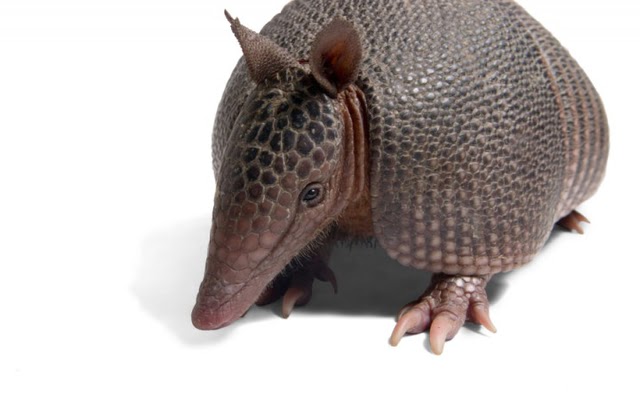
Have you ever visited a desert? The next time you’re exploring the cactuses, be on the lookout for a unique creature. What does it resemble? It’s approximately the size of a small dog and appears ready for battle. What are we referring to? The armadillo, of course!
Just ask anyone who has encountered an armadillo. They are certainly peculiar-looking animals. Why? Their heads, backs, legs, and tails are covered in bony plates, giving them an armored appearance.
In fact, that’s how they earned their name. Armadillo comes from a Spanish word which means “little armored one.” Armadillos are the only mammals in the world that possess such body armor.
There are around 20 different species of armadillos in existence. They are commonly associated with the warm, desert regions of the Southwestern United States. However, nearly all armadillo species inhabit Latin America. Only one, the nine-banded armadillo, resides in the U.S.
Some individuals believe that armadillos are closely related to turtles due to their bony exteriors. This is because the Aztecs referred to them as “ayotoch,” meaning “turtle rabbit.” However, armadillos are actually most closely related to anteaters and sloths.
Armadillos come in various shapes, sizes, and colors. At their smallest, they measure only six inches in length. Giant armadillos can reach a size of five feet or more. Armadillo colors range from pink and dark brown to black, gray, yellow, and red!
The armadillo’s hard shell provides protection against predators. The three-banded armadillo can even curl up its head and tail to form a solid ball, effectively deterring most attackers.
Armadillos dislike cold weather, which is why they prefer warm environments. They can be found in deserts, temperate grasslands, and rainforests. Armadillos also create burrows in the ground as their homes. They spend approximately 16 hours per day sleeping!
They wake up in the early morning and early evening to search for food. Their diet primarily consists of insects, such as beetles, termites, and ants. Since their eyesight is not very good, they rely mainly on their sense of smell to locate food.
Their poor eyesight may also explain another interesting fact about armadillos. In the Southwestern United States, they often wander onto highways and are frequently hit by cars. Their armor often causes damage to the vehicles that collide with them.
Have you ever encountered an armadillo? They are certainly fascinating creatures to observe. However, if you do come across one, remember to keep your distance. Armadillos are wild animals and may carry diseases. Additionally, they can jump up to four feet high when startled. Never approach an armadillo stealthily!
Give it a Try
Let’s celebrate armadillos! Continue learning about these captivating creatures by engaging in one or more of the following activities with a friend or family member:
Have you ever witnessed a live armadillo? They are inquisitive creatures! Explore Armadillo Pictures online to view a variety of armadillos. Would you consider having an armadillo as a pet? What would be the biggest challenge of keeping an armadillo as a pet? Discuss this with a friend or family member.
The giant armadillo, which inhabits South America, remains a mystery to scientists. It is a rare species that has evaded discovery for many years. However, recent advancements in technology have allowed scientists to capture images of a giant armadillo and its offspring. Visit Caught on Camera to view the photograph and learn more about these fascinating creatures!
Can you assist the armadillo in need? They require help in figuring out how to safely cross the road! Your mission, if you choose to accept it, is to create a series of roadside billboards to educate and uplift the armadillos in your area. (Don’t worry, if armadillos are not found where you live, you can pretend!) What should the billboards convey? That is up to you! Can you design an informative billboard that would assist armadillos in understanding how to cross the road safely? (Let’s pretend that armadillos can read, too, while we’re at it.) Be as imaginative as you like! We, along with all the armadillos in Wonderopolis, can’t wait to see your creations!
Wonder Sources
- http://en.wikipedia.org/wiki/Armadillo (accessed 13 Aug 2019)
- http://animals.nationalgeographic.com/animals/mammals/armadillo/ (accessed 13 Aug 2019)
- http://mentalfloss.com/article/69790/8-more-absurd-facts-about-armadillos (accessed 13 Aug 2019)





Leave a Reply